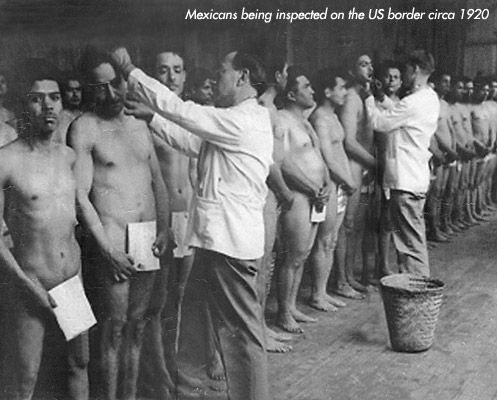Immigration to the West: Immigration Implications Leading Up to the Great Depression
The above video is created by writer John Green on his online educational YouTube Channel called "Crash Course". Published on August 15, 2013, he discusses immigration to the United States during the late 19th and early 20th century, primarily in New York, but also across the nation including to the American West.
Immigration has long been, and largely been, a social and political issue in American history. Primarily, the argument that often divided Americans during the 1920s to 1930s was between providing a home and a chance at a better life to anyone who came knocking, to the other side of the argument, that there needed to be stricter immigration laws - and we even still see this in the present day America. Despite this argument, there was a need for labor in the United States that was not as readily filled by the American population. Despite the U.S. wanting to become an isolationist country after World War I, it began to open the possibility for immigrants to enter the country through famous places like Ellis and Angel Islands in addition to the Mexican border and various places along the coast. This section will analyze why immigrants came to the western part of the U.S. during the 1920s and the 1930s in order to understand in detail the broad scope of this topic. Specifically, this will tackle the “want” for immigrants to come to the American west as well as the “need” for immigrants to migrate to the American West.
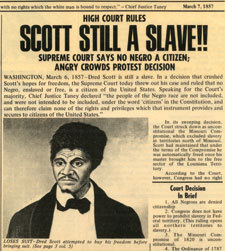
Dred Scott Newspaper headline, March 7th, 1857.
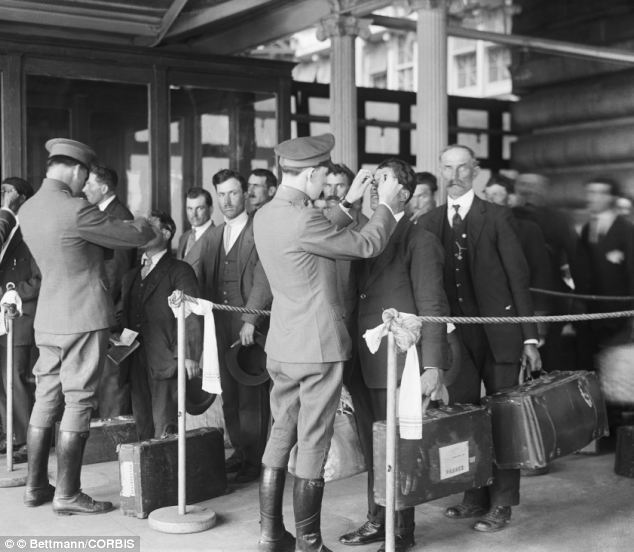
European immigrants being inspected for health conditions at Ellis Island, c. 1920s.
First, it is important to understand that legislation played a huge role in the immigration movements during the 1920s and 1930s. Legislation was the key to establishing a precedent when it came to immigration and largely dictated who could enter the country, for what purpose they could enter the country, and how many could enter the country. The section entitled "Politics and Law" will address legislation and politics on the subject of immigration more thoroughly, but it is important to understand that when discussing why immigration was a powerful force in the American West, the legislation that came before the era created implications for migrant people. The several court rulings and legislative issues that occurred since the mid 1800s, allowed immigration to occur, but at a limited rate and with stipulations that often disqualified anyone who did not hold “white citizenship”. There were legislative rullings on blacks, Asians, Europeans, and Mexicans and despite these complicated restrictions, people still flocked to the US [1]. One of the first and most influential legislative mandates regarded the topic of non-Americans entering the country and ultimately claiming citizenship, and it began with the Dred Scot v. Sandford (1857). This case resulted in the denial of freed, as well as non-free, slaves the right to become citizens, regardless of where they were born. Moreover, this was the beginning of measuring one’s “whiteness” - an important argument during the 1920s. Inherently, a black freed slave was not considered a citizen because even though they were “free” they weren’t “white.” Thus, citizenship became an issue over being white which became the beginning definition for future citizenship, racial, and immigration laws to come. Once the Dred Scot case resolved, the issue of citizenship for blacks was unclear so politicians sought to fix this problem. They began with the Civil Rights Act of 1866 which stated that anyone born in the United States was a citizen, with the exception of Native Americans. That same year, the Fourteenth Amendment was enacted which had the same stipulations as the Civil Rights Act. However, as later discovered, it did not address races other than obvious black and white – leaving out Mexicans, Asians, and Europeans. For example, a man by the name of Wong Kim Ark was a Chinese American, born in San Francisco, and was visiting China when he was denied access back to the U.S. despite him being born in the U.S. Since he was not white, but also not black, this sparked controversy as to whether or not the Dred Scot ruling should be applied to Asians as well. Eventually it was ruled that his citizenship derived from where he was born – thus citizenship now was applicable to Asians – but not for other races. To the U.S. government, this was an issue that needed to be resolved. There were several legislative rulings that helped in this strange fight. There was the Chinese Exclusion Act which limited the immigration of Chinese laborers, the 1907-1908 Gentleman’s Act which reduced Japanese immigrants, and the 1924 Immigration Act which imposed specific quotas in order to help limit immigration on all races [2].
With legislation addressed briefly in order to understand the role of legislation on immigration and its effect on citizenship, it is easier to acknowledge the initial argument and why it was a controversial topic during the 1920s and 1930s. There was a large labor shortage that needed to be filled, especially in the west. For example, on December 13, 1923, the National Immigration Conference was hosted by the National Industrial Conference Board where 500 delegates came together from 150 different organizations in order to provide information to Congress in order to make an immigration policy. The consensus among manufacturers and agricultural businessmen was that there should be immigration restrictions but they should not limit skilled workers. Social workers wanted far fewer restrictions, where others believed that restrictions should be in place but the quota should exclude skilled workers to help with the labor struggle. Overall, it was acknowledged that though there should be restrictions on immigration in order to help limit an overpopulation of immigrants and therefore, not enough work, they did not want to limit skilled labor because of the need for skilled workers in the 1920s [3].

This was a political cartoonpublished in the Chicago Tribune c.1920 entitled, "Close the Gate."
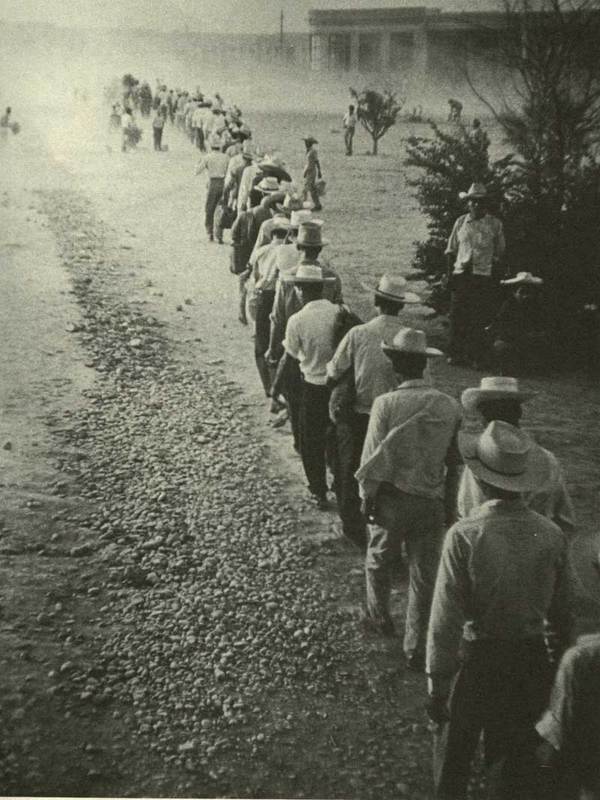
Mexican immigrant processing depot in the 1920s.
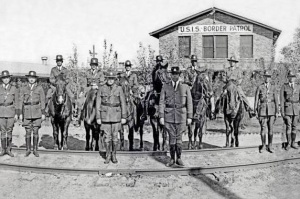
El Paso, Texas 1927 U.S. Immigration Service Border Patrol inspectors in formation in front of the Border Patrol's first training facility in Camp Chigas.
However, the biggest concern that businessmen and American citizens had when discussing immigration laws was not just labor but also social implications. There was a huge fear that an increase in immigration would also create issues between citizens due to cultural differences. As a result, people felt the need to pose restrictions due to the lack of cultural assimilation from immigrants into the nation. Secretary of Labor, James J. Davis, released a front page review in The New York Times regarding the “Alien Problem” on February 17, 1924. It was entitled “One Hundred Years of Immigration” and aimed to shine a light for the American public on the benefits and negatives of immigrants, and furthermore, the stance he believes Congress should take when drafting new legislation between February and June of 1924 - ultimately resulting in the aforementioned Immigration Act of 1924. It stated that over the last century, such an increase in immigration has occurred that if not restricted in the future, that the “flood gates will be open and undoubtedly there will be the biggest inundation of foreigners” from Europe, Mexico, and the far East. He did mention that the obvious restrictions would be on “women for immoral purposes, … idiots and others mentally deficient, and likely to become public charges” which included polygamists, anarchists, contract laborers, criminals, and those with diseases. According to Davis, he stated that in 1921 alone, there was over one million immigrants that enter the country, purely on the basis for work since labor opportunities and working conditions were so poor in the majority of other countries. He continues to elaborate on the reasons for the increase in immigration due to wars, political changes, and economic depressions in various other countries. The next piece to his argument was that because of such an increase in immigration, it would drastically change the “ideals, customs, manners, government, economics, business, labor, art, religion, and education” because America has failed to assimilate immigrants in the past. On the argument of assimilation and naturalization, the highest number of immigrants that did not become naturalized for at least ten years were Mexicans. Ultimately, Secretary Davis’ stance was for stricter immigration laws through selective immigration on race, political views, social class, non-naturalizable, intellect, and health in order to increase “better aliens for America and a better America for both aliens and citizens”[4].
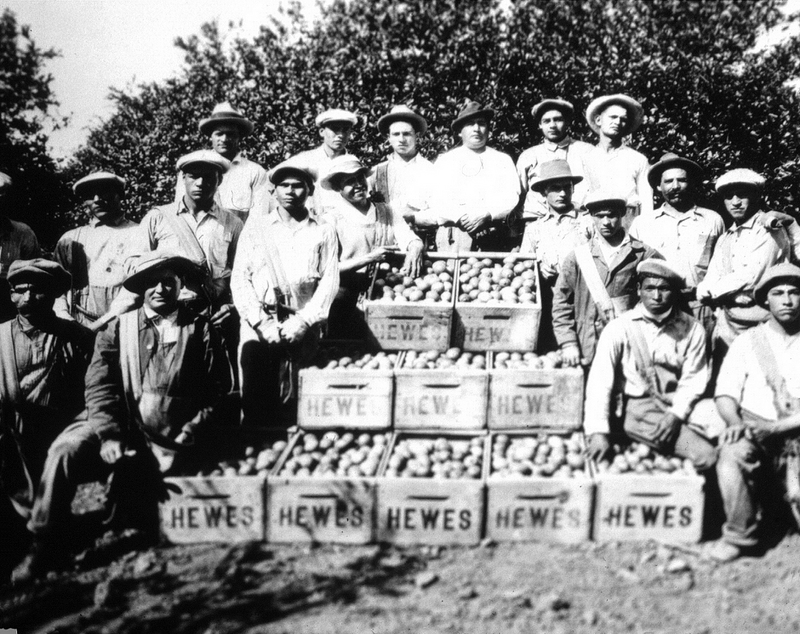
A group of Mexican migrant workers pose for a picture at Hewes Ranch, with oranges, in Orange County, c.1920.
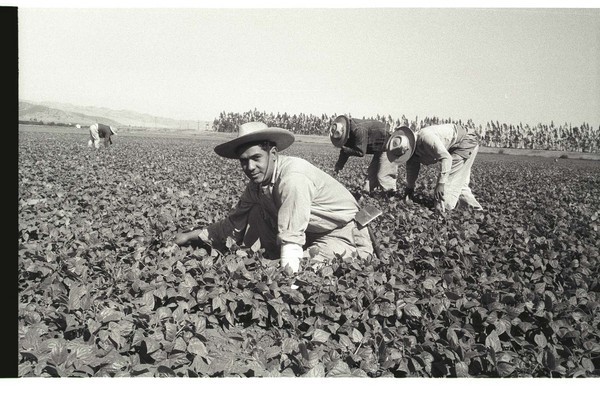
A Pepper Bracero, bracero meaning "manual worker", c. 1920s.
This discussion and research presented, especially the statistic on Mexicans not becoming naturalized citizens, as well as the unfavorable rhetoric toward immigrants, largely attributed to the push against Mexican immigrants entering the country and furthermore, impacting immigration in the west. Mexicans were a huge driving force in the agricultural sector of western development. The Mexican population wanting to make a living in America and the jobs that were available were primarily in agriculture. The agricultural jobs were not sought after by naturalized citizens due to the grueling nature of the labor. But Mexican immigrants, as well as other nationalities, pursued them despite getting paid less than what the labor was worth. This was because regardless of the pay not meeting the market or labor standard, they were still making more than what they would have in Mexico. These jobs were so sought after in the west, that Mexicans made up roughly three-quarters of the agricultural labor force during the 1920s, prior to the Immigration Act of 1924. When the Great Depression arrived, the previous anti-non-white sentiments began to grow and minorities paid the price – displacing almost the entire previous three-quarters of the agricultural labor force [5].

During the 1920s and Great Depression, migrant workers often lived in poor conditions. Here is an image of Mexican migrant sugar beet workers who lived together in this one room house, c.1920s.
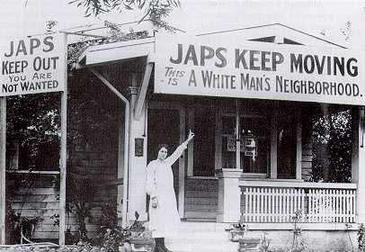
Nativism was prevelant during the 1920s awnd 1930s. Here is a woman outside of her home pointing to anti-Japanese signs, California, c. 1920s.
As a result of the Depression, minorities were blamed for the economic downturn and began to be targeted for layoffs as well as deportations and hate crimes. This blaming was placed on Chinese, Japanese, and Mexican immigrants, as well as other immigrants throughout the 1930s. Historically in America, whenever there was an economic downturn, labor shortage, or other related issue, minorities were blamed for the problem and this was exactly the case in regards to the Great Depression. The citizens’ outrage helped fuel stricter legislative reforms and also the decline of intercultural sentiments. Hate crimes became more prevalent and illegal deportations became more and more common. Despite the blood, sweat, and tears that immigrants shed in order to help build America during the 1920s, this was forgotten. Race was becoming a greater issue and the majority was aiming to find any reason to support the idea that minorities were inferior [6].
Based off of the previous legislative implications placed upon minority groups, much like Mexicans in the west as well as other groups, the argument of stricter immigration reformations or looser immigration reformations was an ongoing topic throughout the 1920s and 1930s. However, heightened tensions between immigrants, government, and American citizens at large, were largely caused by “statistical” evidence from influential political leaders, personal opinion of the public provided by the media, as well as the culmination, or “nail in the coffin”, of the economic downturn of the Great Depression. The 1920s and prior set up a difficult and grim picture for immigrants when moving forward during the 1930s. For immigrants, the future hate crimes, illegal/legal deportations, targeting, and negative media portrayal heavily contributed to social and political tensions in immigrant households in the west, and even across America. For immigrants, they felt that the actions taken infringed upon their basic human rights and civil liberties. For the opposing side, they had the same argument but with the spin that it was the minority presence that was infringing upon these rights and ultimately making the situation worse [7]. From exploring the remainder of this exhibit, a deeper understanding about immigration in the 1930s will be gained in regards to how life at home and within the family dynamic for immigrants changed in the American West. Furthermore, minorities in the west, specifically Mexicans and Asian Americans, experienced major social changes within their community as well as among citizens causing social movements and new labor laws. Finally, legislation overall paired with social beliefs influenced future legislative acts as well as actions taken by non-governmental citizens, which drastically impacted how immigration was seen during the 1930s as well as for years to come.
[1] McCaa, Robert. “The peopling of Mexico from origins to revolution,” in Michael R. Haines and Richard H. Steckel (eds.) A Population History of North America. New York: Cambridge University Press: 2000. 241–304.
[2] Molina, Natalia. How Race is Made in America: Immigration, Citizenship, and the Historical Power of Racial Scripts. Berkley: University of California Press, 2014.
[3] "FAVORS SELECTIVE IMMIGRATION LAW." 1923. New York Times (1923-Current File), Dec 14, 20. http://ntserver1.wsulibs.wsu.edu:2098/docview/103167740?accountid=14902.
[4] Davis, James J, Secretary of Labor, 1924. "ONE HUNDRED YEARS OF IMMIGRATION." New York Times (1923-Current File), Feb 17, 1924. http://ntserver1.wsulibs.wsu.edu:2098/docview/103447000?accountid=14902.
[5] Depression Era: 1930s: Repatriation for Mexican & Filipino Farm Workers." Picture This: California Perspectives on American History. Accessed September 21, 2016.
[6] McNeill, Allison, et. al. "Minority Groups and the Great Depression." Great Depression and the New Deal Reference Library, vol. 1: Almanac, UXL, 2003, pp. 172-186. U.S. History in Context, link.galegroup.com/apps/doc/CX3425600021/UHIC?u=oldt1017&xid=4c75c3e4
[7] Kennedy, Rita. “Asians in America During the Years From the Great Depression to WWII.” Synonym.com, 2001-2016. http://classroom.synonym.com/asians-america-during-years-great-depression-wwii-5524.html
